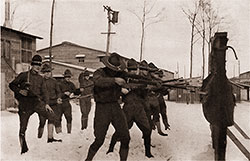Camp Devens - World War 1 Cantonment – A.E.F. Training Center 1918

Front Cover, Camp Devens: Described and Photographed with Inset Photo Showing the Main Gate to the Camp. GGA Image ID # 19cd5f5e72
Camp Devens, Massachusetts, was named in honor of Brigadier General Charles Devens, served as a training camp for 76th Division (National Army), which occupied the cantonment, August 1917 to July 1918. Numerous photographs and descriptions of camp activities, buildings, and soldiers.
Camp Devens: Described and Photographed

The construction of the cantonment of the Seventy-Sixth Division was a triumph of engineering and contracting skill, and a monument to American efficiency and industry.

The Mobilization of the Citizens
The chairman of the board spoke a few words to them, several political leaders shook their hands, slapped their backs, and marched them down the street to the station. And now John and his newly made friends are waiting for the train, under the watchful eye of the board chairman.

Recruits Make Their Way to Camp Devens
Around the bend the column goes, every man hot and perspiring. On the right is the parade ground, stretching along for half a mile. On one side of it the men see long lines of infantry barracks laid out in perfect order. In front of them is the depot brigade, — their destination.

Bird's-Eye View of Camp Devens
Below the skyline, in the center of the picture we have the 303rd and 304th Infantry and looking over the YMCA. Auditorium at the right, one sees the barracks of the 301st and 302nd Infantry. The conspicuous chimneys mark the situation of the various heating-plants of the camp.

Important Buildings at Camp Devens
A number of important buildings were constructed at Camp Devens including the 76th Divisional Headquarters building, 301st Infantry Divisional Headquarters, Officers' Quarters, Base Hospital Headquarters, Base Hospital Barracks, and the Camp Fire Department.

Socializing and Entertainment at Camp Devens
The need for socializing and entertainment for the troops at Camp Devens was undertaken by three primary organizations. The YMCA, The Knights of Columbus, and The Hostess House. The latter being primarily for the benefit of women who visited Camp Devens.

Training the Soldiers at Camp Devens
Army leaders not only encourage exercise on the part of the men but also require a certain amount of physical training as a part of the day's work.
Regiments at Camp Devens

301st Infantry Regiment at Camp Devens
The 301st Infantry Regiment of the 76th division is situated a hundred yards to the south of the Divisional Headquarters. The commanding officer is Colonel Frank Tompkins. Topics include barracks, belongings, and the firing range.

The 302nd Infantry, Colonel C. C. Smith commanding, comes from the southeastern part of Massachusetts. Some of the men came from Quincy, Hingham, and towns near Boston; others lived in Provincetown and the villages of Cape Cod, on Martha’s Vineyard and Nantucket.

The men of the 303rd Infantry are the only ones at Ayer who were not residents of New England; they come from northeastern New York state, from Albany, Schenectady, Johnstown and other towns and cities in that section.

From Connecticut comes the 304th Infantry, under Colonel J. S. Herron; a large number of its men were formerly employed by the industrial plants of Bridgeport, Hartford, New Britain and Waterbury.

Field Artillery Brigades & Regiments at Camp Devens
Camp Devens has three regiments of field artillery: the 303rd, heavy artillery, the 301st and 302nd, light artillery. Colonel A. S. Conklin is the commanding officer of the combined regiments. The enlisted men are those drafted from Northern Maine and New Hampshire.

The Medical Corps at Camp Devens is under the direction of Lieutenant-Colonel Powell, the divisional surgeon, who has under him 230 officers and 1,100 men. Besides the base hospital there are twenty-six infirmaries, attached, for the most part, to the regimental units.
Roger Batchelder and Major Roger Merrill (Foreword), Camp Devens, Described and Photographed, Small, Maynard & Company, 1918.
